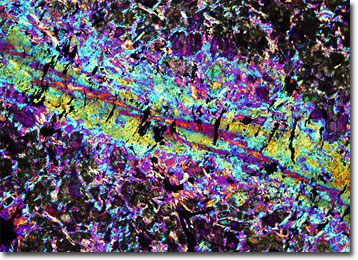Polarized Light Microscopy Digital Image Gallery
Serpentinite
The term serpentine is applied to any of a grouping of hydrous magnesium-rich silicate minerals that are typically gray, green, or white in color. A type of rock that is almost completely composed of serpentine is known as serpentinite.

Associated with subduction zones, serpentinite is a metamorphic rock that is formed from the action of high pressure and heat upon hornblende schists or igneous rocks composed chiefly of mafic minerals, such as peridotite, gabbro, or basalt. The substance is most often found in areas where mountain ranges have formed due to the sealing off of an ocean basin. For instance, the Coast Ranges in California, where serpentinite is the official state rock, primarily consist of slices of the oceanís crust that have been faulted and folded along the coastline. Relatively weak, mountains containing high levels of serpentinite may suffer from recurrent landslides and a brisk erosion process.
Due to its derivation from the Earthís mantle, protrusions of serpentinite are often quite different from the environment that surrounds them. Indeed, the rockís low levels of calcium and potassium, as well as its significant amounts of such potentially harmful substances as chromium and nickel, would seem to make it an unlikely place for habitation. However, some plant species have been able to successfully adapt to the unusual characteristics of serpentinite. For example, in Presidio of San Francisco, which is part of the Golden Gate National Recreation Area, several endangered species of plants have become acclimatized to life on serpentinite outcrops.
